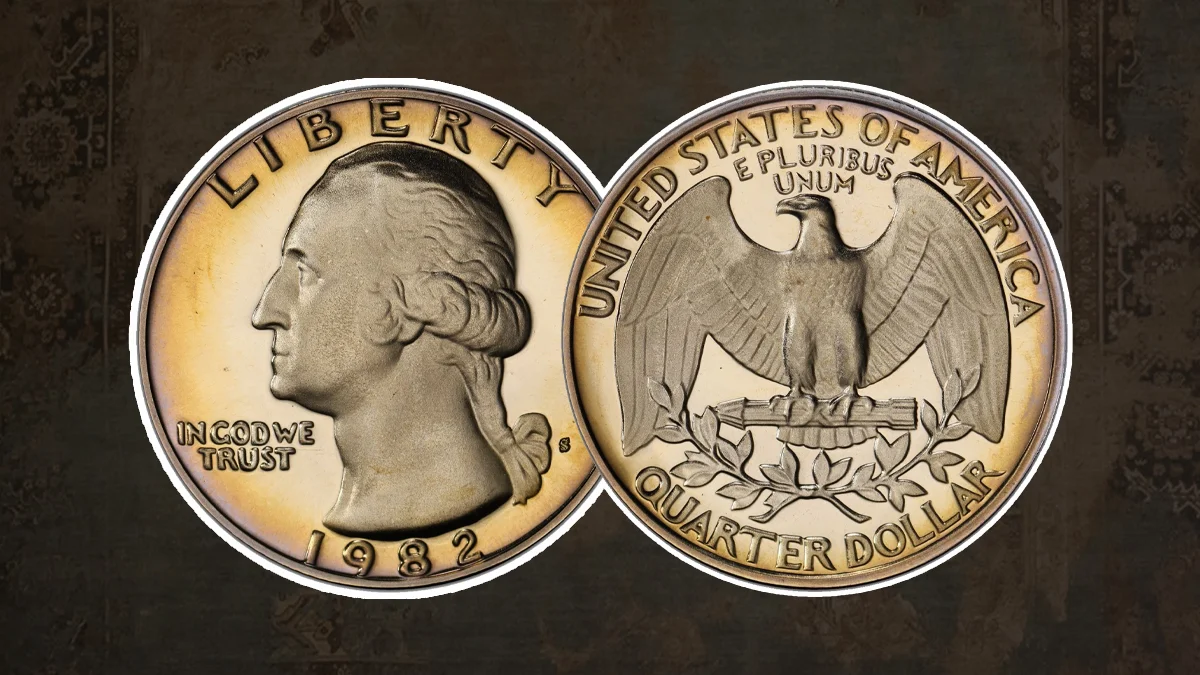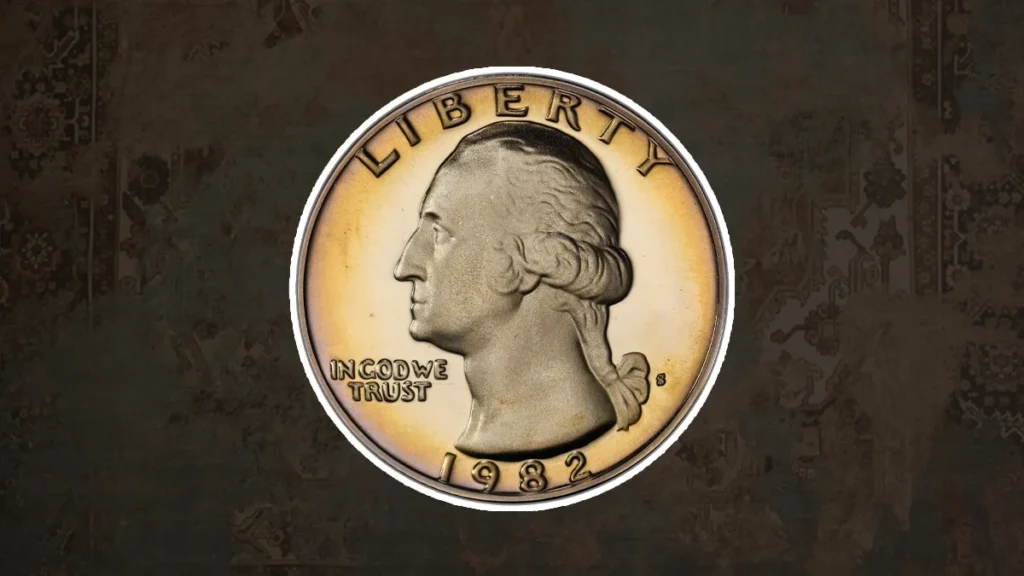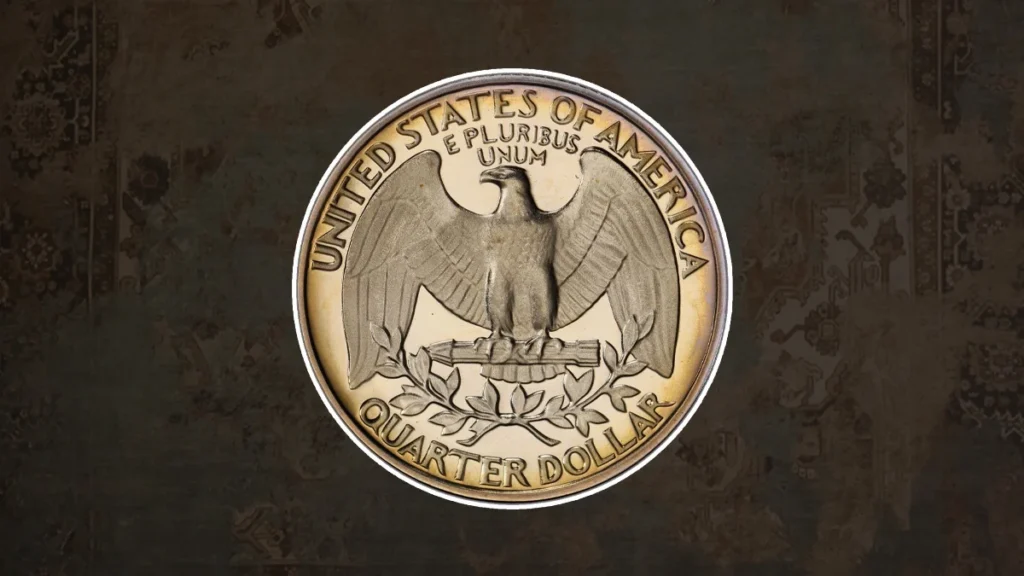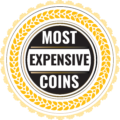
Have you ever found a 1982 Washington Quarter in your currency and are unsure of its future value? This article will explain every detail you need to know about coins, no matter whether you’re a collector or just curious about their value. We’ll analyze the 1982 quarter’s design, rarity, history, and errors to help you evaluate its current market value. To find out if your quarter is valued more than just 25 cents, let’s start!
History of the 1982 Washington Quarter
With its initial minting in 1932, the Washington Quarter has enjoyed a lengthy and illustrious history. In celebration of George Washington’s 200th birthday, it was first introduced. Washington was America’s first president. These quarters used to be made in silver, but when silver prices grew, their value increased and silver had been eliminated from the coin’s composition in 1965.
After the silver coin phase-out, the U.S. Mint devised a more affordable option and by 1982, quarters with a copper core and a cupronickel (copper-nickel) clad were being minted. 1982 saw a notable change in Philadelphia-minted quarters as well because it was the first year they were imprinted with the Philadelphia Mint’s “P” mint mark. The San Francisco Mint made proof quarters for collectors, while the Denver Mint struck quarters with a “D.”
The 1982 quarter came out at a period when the economy needed millions of pieces to be in circulation, thus even with its high mintage, it has a unique place in numismatic history. Additionally, some of the Most Valuable Modern Quarters stem from this era, adding to its significance among collectors and enthusiasts alike.
Specifications of the 1982 Quarter
- Composition: Cupronickel-clad copper (91.67% copper, 8.33% nickel)
- Weight: 5.67 grams
- Diameter: 24.3 mm
- Edge: Reeded (119 reeds around the edge).
Design of the 1982 Quarter
Obverse

The 1982 Washington Quarter’s obverse side has the popular George Washington profile, facing left. For almost a century, this work of art, designed by John Flanagan, has decorated the quarter. The words “LIBERTY” on top and “IN GOD WE TRUST” to the left surround Washington’s head. The minting year, “1982,” is under Washington’s neck, and the mint mark, either “P” for Philadelphia or “D” for Denver, is to the right side.
It’s important to keep in mind that this design was never intended for the Washington Quarter. The first choice was a painting of Washington by Laura Gardin Fraser, but Flanagan’s depiction had been selected by Treasury Secretary Andrew W. Mellon. At the time, this decision caused controversy and discussions over whether gender prejudice had an impact on Mellon’s decision-making process.
Reverse

The reverse side of the 1982 quarter was designed by John Flanagan. It shows a majestic bald eagle perched on a bundle of arrows, representing strength and preparedness. Below the eagle, olive branches symbolize peace. The eagle wings frame the description “UNITED STATES OF AMERICA” at the top side, while the national motto “E PLURIBUS UNUM” is written above the eagle’s head. At the bottom, the denomination is clearly expressed as “QUARTER DOLLAR.”
This iconic design remained unchanged from its introduction in 1932 until 1999 when the U.S. Mint launched the famous State Quarters program.
Rarity and Condition of the 1982 Quarter
It is not extremely rare to find a quarter from 1982 in circulation, with the high mintage numbers of that year. Finding one in perfect, fresh condition, however, may significantly change its value. Circulated 1982 quarters have an excellent rate of survival, but higher-grade mint state coins (MS65 and above) are far more scarce, which makes them more expensive. For an accurate assessment of your coin’s worth, you can use a Coin Value Checker.
- 1982-P (Philadelphia): The Philadelphia Mint made more than 500 million of these quarters, making them one of the most widely used coins. High-grade variations, MS65 and above, are rare, though.
- 1982-D (Denver): The Denver Mint made almost 480 million quarters. Circulated quarters are large, comparable to the Philadelphia edition, but excellent uncirculated examples are hard to find.
- 1982-S (San Francisco): Only proof quarters were manufactured by the San Francisco Mint, with collectors in mind. Because of their limited mintage, these coins rarely appear in circulation.
1982 Quarter Errors
The possibility of finding a unique error is one of the most exciting things about coin collecting. In 1982, several important errors occurred, increasing the value of selected quarters.
1982-S Obverse Double Die (Proof)
A double die error occurs if the coin doubles as a result of a tiny change in the die during making. Parts of the obverse writing on the 1982-S proof quarter show this doubling. Collectors value quarters with this defect highly since they are rare. Depending on its condition, a PR69 double die obverse proof may be valued at as much as $800.
1982-D Reverse Double Die
A fascinating error occurred at the Denver Mint when some quarters had a double-die reverse struck on them. The font used on the back side shows this issue, especially with the term “QUARTER.” Higher-grade coins with this error can fetch hefty premiums; MS65 examples can fetch up to $75 in value.
Grading the 1982 Quarter
Coin grading is important to determine a quarter’s value, as coins in higher grades are extremely valuable. The following is a breif summary of the coin grading system:
XF45 (Extremely Fine): Overall clear detailing, with little wear on the design’s highlights.
MS60 (Mint State): Shows no wear but may have limited errors such as scratches or marks.
MS65 (Gem Mint State): A well-struck coin with very small errors under magnification is designated.
Coins graded MS67 and above (Superb Gem Mint State): These are almost spotless, having crisp striking and virtually no visible flaws.
1982 Quarter Value
The value of a 1982 Washington Quarter depends on its condition, mint mark, and errors. Here’s a general value guide for the 1982 quarter:
| Mint Mark | XF45 | MS60 | MS65 | MS67 |
| 1982 P | $0.25 | $1 | $42 | $500 |
| 1982 D | $0.25 | $1 | $26 | $375 |
For proof coins:
| Grade | PR60 | PR65 | PR69 | PR70 |
| 1982-S | $2 | $6 | $15 | $36 |
Quarters with errors like double dies can bring even higher prices, especially in higher grades.
Related Posts –
- 1981 Washington Modern Quarter: A Comprehensive Guide
- 1971 Washington Quarter: A Complete Guide
- 1970 Washington Modern Quarter: A Complete Guide
- 1969 Washington Modern Quarter: A Comprehensive Guide
Conclusion
Even though the 1982 Washington Quarter is commonly accessible in circulated form, its value can be significantly enhanced by several factors, like mint condition, proof versions, and errors. These coins have historical and monetary value, whatever your level of collecting interest. If you find one in excellent condition or with a rare minting error, the value rises even further. If you think your coin might be worth more than face value, always think about having it professionally graded!
